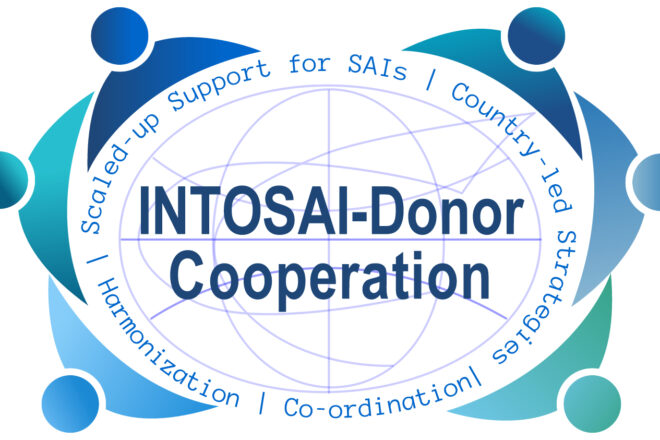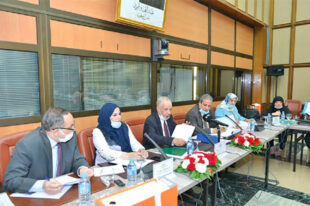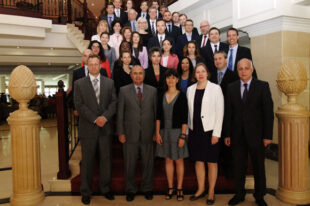Personal Thoughts, Reflections on the Cooperation

by Martin Aldcroft, Head of the INTOSAI-Donor Secretariat
After serving the INTOSAI-Donor Secretariat (IDS) for six years, this is, perhaps, the last article I will write as a member of this inspirational organization. Mr. Ole Schoyen now leads IDS, along with a team comprised of several new staff members. I will remain with the INTOSAI Development Initiative (IDI)—hoping to help the new IDS team avoid similar mistakes I made and hoping to provide solutions to potential future missteps.
In this article, I give my personal thoughts and reflections on INTOSAI-Donor Cooperation (Cooperation). Why is it needed? What has it achieved to date? What could, and should, it do in the future?
INTOSAI-DONOR COOPERATION—THE NEED
Providing support to developing countries is hard. Challenges arise from differing priorities between those providing support and those in need of it. Difficulties also stem from the sheer volume of organizations, all well-meaning, who want to lend support.
In many developing nations, the landscape is littered with a variety of donors, including Non-Governmental Organizations at the national level in addition to peer support through Supreme Audit Institutions (SAIs) that, frequently, have no national-level presence. The goal—to ensure all support adds up to more than the sum of its parts. Too often, in the past, the opposite has been true.
In my experience in Vietnam, working on an EC-funded project with the State Audit of Vietnam (SAV) from 2006-2007, numerous donors and SAIs provided simultaneous support, including the Cooperation, Deutsche Gesellschaft für Internationale Zusammenarbeit (GIZ), the World Bank, Asian Development Bank and the SAIs of Denmark, Hungary and Norway.
Projects overlapped heavily, and coordination mechanisms were weak or non-existent. The SAV was receiving advice from multiple sources using multiple approaches. There were no performance audit International Standards of Supreme Audit Institutions (ISSAIs) we could all get behind. I am certain the end result for the SAV was one of confusion. After speaking with technical advisors operating in other countries, I realized this chaos was the norm, not the exception.
Prior to that, in 2004, I was fortunate to be involved in a project supporting the SAI in Sierra Leone. As an enthusiastic junior on the team, I found myself reviewing the draft program document designed to formulate the undertaking’s expectations. It was a tangled mix of activities and results that we wanted the SAI to achieve. I couldn’t wrap my head round it…were WE setting goals for the SAI?
The answer surprised me, though it probably shouldn’t have. The SAI had no projected future path, no defined results. In short, there was no strategic plan. Rather than aligning behind a SAI-led strategy, we were driving the process based on our priorities. This, too, turned out to be a common problem replicated on projects in many other countries.
Globally, the development community began waking up to these issues. The Paris Declaration (signed in 2005) led to countries agreeing on principles intended to improve how aid was provided, specifically developing country ownership, donor alignment, harmonization of support, managing for results, and mutual accountability.
The INTOSAI and Donor communities embraced these principles in 2009 when 15 Donors and INTOSAI signed a Memorandum of Understanding (MoU) aimed to increase and improve SAI support. Thus, the Cooperation was born. All agreed to ensure support was synchronized or coordinated to avoid overlaps and confusion. And, all committed to support INTOSAI’s strategic priorities, such as the International Standards of Supreme Audit Institutions (ISSAIs).
The Cooperation became the principal forum for discussions between INTOSAI and Donor communities around the shared goal of strengthening SAIs to improve governance, fight corruption and contribute to better lives for citizens. The Cooperation helps communicate the message on SAI importance; advocates to deliver support according to MoU principles; and seeks to change the behavior of those receiving and providing support. The Cooperation also addresses pertinent issues on strengthening SAIs; carries out and disseminates research findings to improve SAI support; and is provides and promotes continual lesson learning.
INTOSAI-DONOR COOPERATION—THE ACHIEVEMENTS
As the Cooperation progressed, emphasis on better understanding SAI needs and performance also advanced. Gradually, we learned how SAI performance was transforming and whether provided assistance was contributing to improvement.
The SAI Performance Measurement Framework (PMF) was created to enable SAIs to comprehend and measure performance over time. As more SAIs undertake SAI PMF assessments, the information pool expands, allowing the Cooperation to see changes over time and answer crucial questions, such as did the resource expenditure contribute in ways that truly matter for citizens?
Major Milestone: Matchmaking
The Cooperation has accomplished numerous achievements. One of the most important part of the Cooperation’s work, in my opinion, is the matchmaking process—uniting a SAI (or groups of SAIs) having specific development needs with a donor and/or INTOSAI support provider.
The Cooperation began matchmaking roughly seven years ago with a concerted effort to mobilize donor and INTOSAI funding for several high-priority global and regional initiatives. The ISSAI Implementation Initiative (3i program) was kick started with a World Bank grant. The Department for International Development (DFID) backed IDI to implement the INTOSAI Capacity Building Committee’s guides and support. Switzerland supported SAI strategic planning work in French-speaking African SAIs (CREFIAF), as did the Inter-American Development Bank in the Caribbean Organization of Supreme Audit Institutions (CAROSAI) region. The success of these initiatives led greater opportunities for all SAIs, INTOSAI regions and INTOSAI committees to seek support benefitting SAIs in developing countries.
Major Milestone: Global Call for Proposals
The biggest, most fundamental shift in the way we provide support to SAIs is through the Global Call for Proposals (GCP), where recipient SAIs define needs and write proposals. Prior to this approach, a dialogue between donors and recipients took place, agreements were reached, and, often, donors drafted the proposals that they were prepared to fund.
Having worked several years in a donor organization prior to my tenure with IDS, I have seen a wide variety of practices ranging from excellent dialogue, donor staff who really listen, and proposals that were jointly- or SAI-led to donors pushing personal agendas and developing entire project proposals with no SAI involvement whatsoever.
Initially, there was some resistance to the new method of project proposal development. It was risky. Would SAIs have the time, skills, experience? With some support (and a lot of practice), SAIs have been articulating needs and putting them forward since 2011.
We realized we were asking SAIs to develop proposals with no guarantee that, in the end, they would be funded, particularly since very few donors could support large-scale infrastructure projects. Yet, some themes, such as ISSAI-based cooperative audits, SAI PMF assessments and strategic planning initiatives, were hugely successful.
Ensuring proposals were (1) of sufficient quality and (2) targeted areas were considered a priority to donors were additional challenges. All in all, nearly half of the proposals received some form of support in both the 2011 and 2013 GCPs.
The GCP also resulted in Cooperation cohesion, as it required each side to bring its “A” game. Donors wanted proof, “Show us high quality, strategic proposals we can support.”
Quoting the popular phrase from the movie Jerry Maguire, INTOSAI responded (with over 50 proposals), “Show me the money!” Checkbooks opened. Projects started.
Matching and project mobilization is, of course, a slow process. Many years pass between a project start date and resulting impact, such as changes in SAI activities and performance that make a difference to a government and its citizens.
However, we are now beginning to see the fruits of our labor—not just better audits and greater transparency, but better government debt management, revenue collection, environmental protection and service delivery. We are now at a point where we can communicate the success of our work, to show its true value, and, hopefully, maintain support for strengthening SAIs in developing countries.
INTOSAI-DONOR COOPERATION—THE FUTURE
The Cooperation has entered a new, exciting phase. The 2015 evaluation gave us a lot to think about. As the Cooperation is a learning organization, we spent 2016 reviewing strategies in key areas to develop lessons learned and best practices. Now, in 2017, we are in full implementation mode.
The relaunched GCP is key to the Cooperation’s future success. The need to retain all-inclusive opportunities and really focus on reaching the hardest to reach SAIs (those in “challenged” environments) led to the creation of a two-tiered approach. Tier 1, which commenced in March, is now a rolling process (no longer time-bound), allowing SAIs to apply for support when it best suits the SAI’s needs. MoU principles are now at the heart of the GCP.
Tier 2 is a completely new approach that focuses on SAIs in challenged environments, SAIs that are not well-equipped to articulate needs and mobilize support. The list Tier 2 target SAIs, which includes the Central African Republic, Democratic Republic of Congo and Somalia, demonstrates the Cooperation’s intention to make a difference in some of the world’s poorest and most dangerous countries.
The risk of failure is very real, but the potential to make positive change is equally huge. This process requires commitment, long-term partnerships and effective relationship building in an environment typified by strong opposition to SAI reform.
In addition to the GCP, the Cooperation will increase its communications work, promoting the importance of SAIs, the MoU principles and the organization itself. We will move into a new phase centered on results…real results, results that encourage behavioral change in the direction of the MoU principles. The Cooperation will continue seeking success stories to share with our community, successes on how projects were matched and how these matched projects illustrate proven results that benefitted citizens and good governance.
Evaluations still need work. It seems that, too often, many evaluations are completed solely for accountability purposes, with the project itself the focus. From these types of assessments, we learn little about improving service delivery. Evaluations that emphasize SAI review leads to questions on whether and how the various forms of SAI support contributed to performance change. This requires greater coordination–between the SAI and all support providers. Cross-country evaluations, where evidence is used from a number of countries to answer hypotheses on what works (and what doesn’t) is also beneficial. However, when countries and SAIs differ so greatly, are lessons learned from one country applicable to all?
I look forward to the Cooperation’s growth, to watching the new IDS team build upon everything discovered thus far. These are indeed exciting times, and I am thankful that I have played a part in shaping the Cooperation, its mission, its success.





